Analysis of Sainsbury's Organizational Elements on Business Strategy
VerifiedAdded on 2023/01/10
|9
|3160
|97
Report
AI Summary
This business report examines Sainsbury's Plc, a major supermarket chain, focusing on the impact of various organizational elements on its operations, decision-making processes, and overall business strategy. The report explores organizational size, structure, and scope, as well as the different types of organizations, with a primary focus on Sainsbury's hierarchical structure as a large private organization. It analyzes how these elements influence business operations, including the ability to expand, make effective decisions, and formulate competitive strategies. The report also contrasts the impact of these elements on large organizations like Sainsbury's with that of smaller businesses, highlighting the importance of adaptability, effective decision-making, and employee motivation in achieving business success. The analysis includes the influence of organizational structure on the delegation of responsibilities, and the overall impact on productivity and profitability. The report concludes by emphasizing the importance of adapting the business strategies to different market conditions and customer needs.
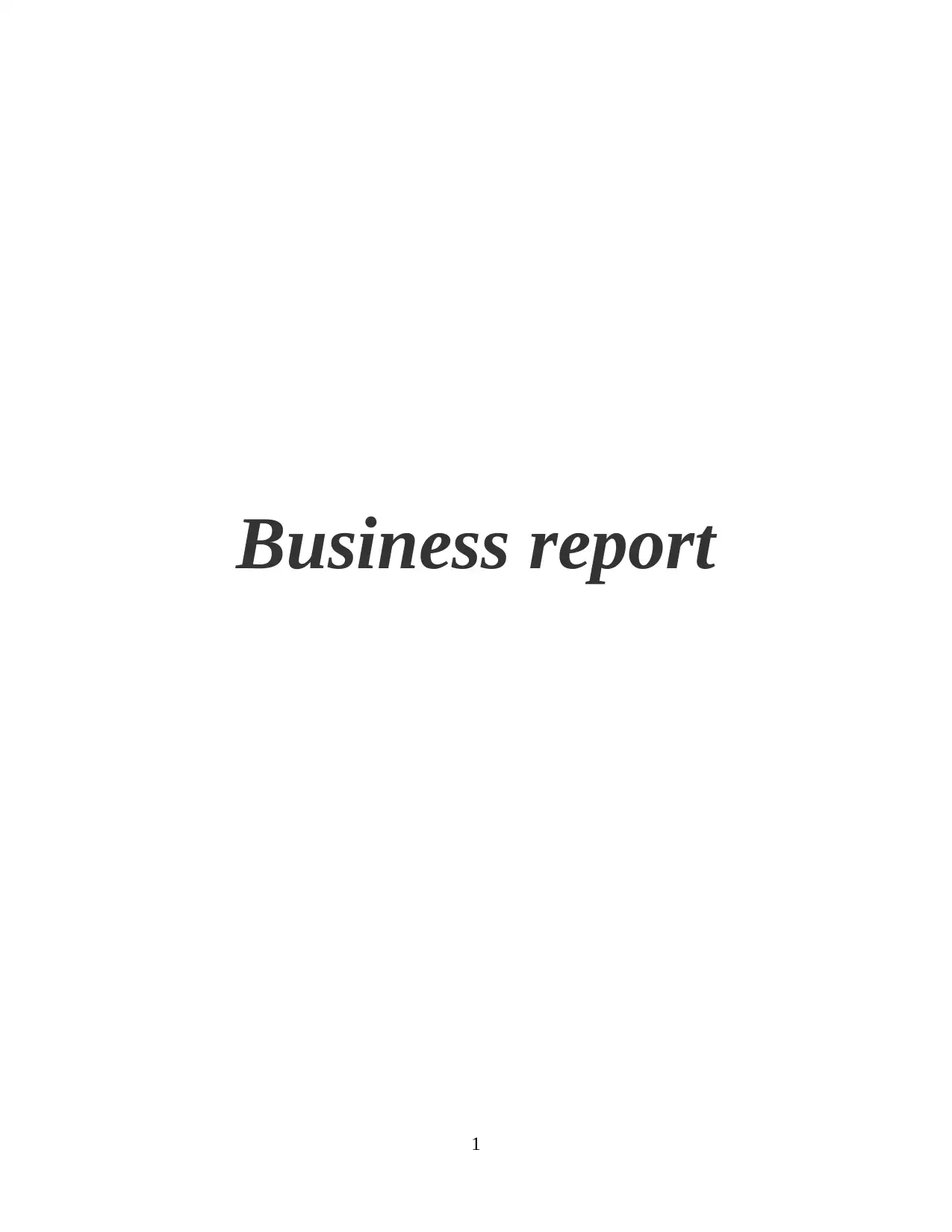
Business report
1
1
Paraphrase This Document
Need a fresh take? Get an instant paraphrase of this document with our AI Paraphraser
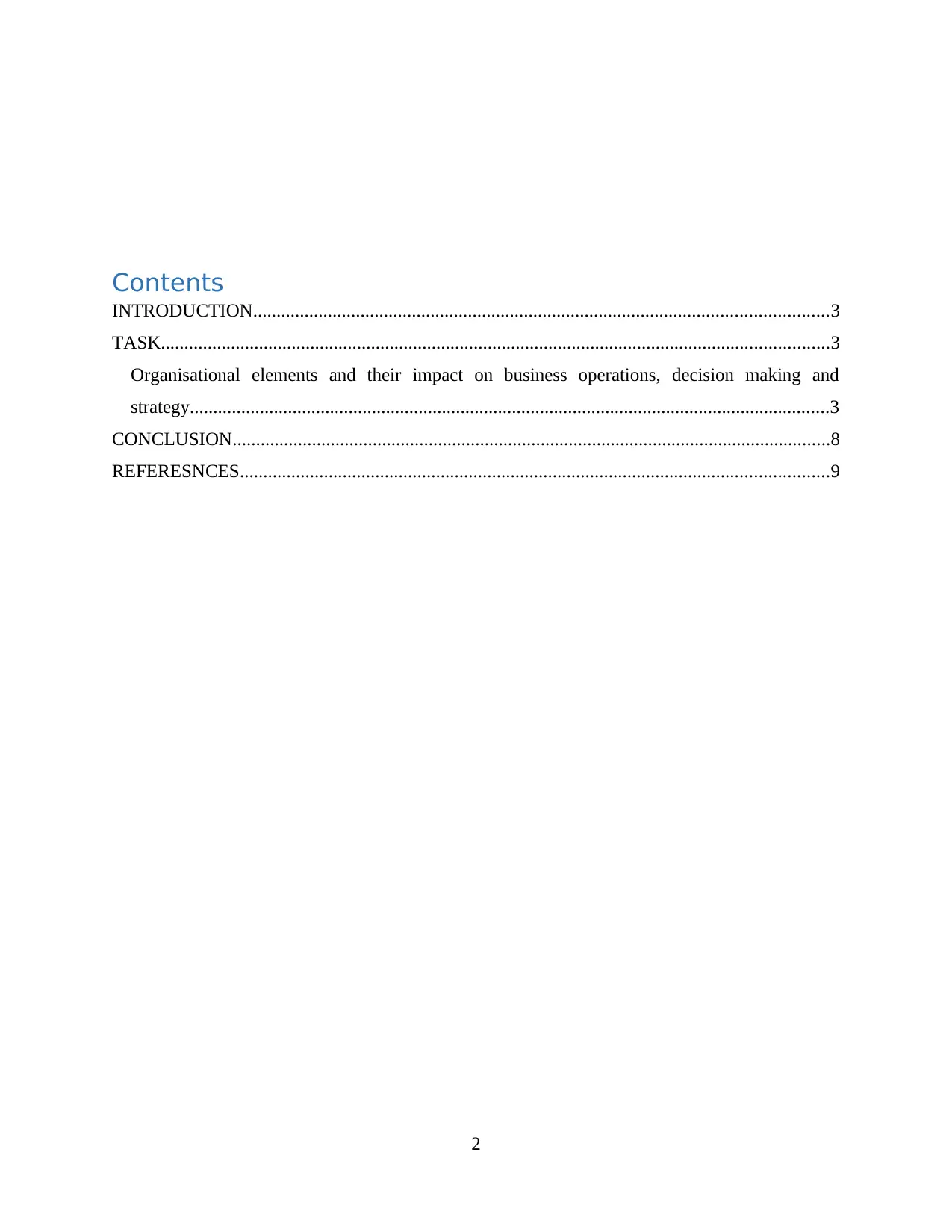
Contents
INTRODUCTION...........................................................................................................................3
TASK...............................................................................................................................................3
Organisational elements and their impact on business operations, decision making and
strategy.........................................................................................................................................3
CONCLUSION................................................................................................................................8
REFERESNCES..............................................................................................................................9
2
INTRODUCTION...........................................................................................................................3
TASK...............................................................................................................................................3
Organisational elements and their impact on business operations, decision making and
strategy.........................................................................................................................................3
CONCLUSION................................................................................................................................8
REFERESNCES..............................................................................................................................9
2
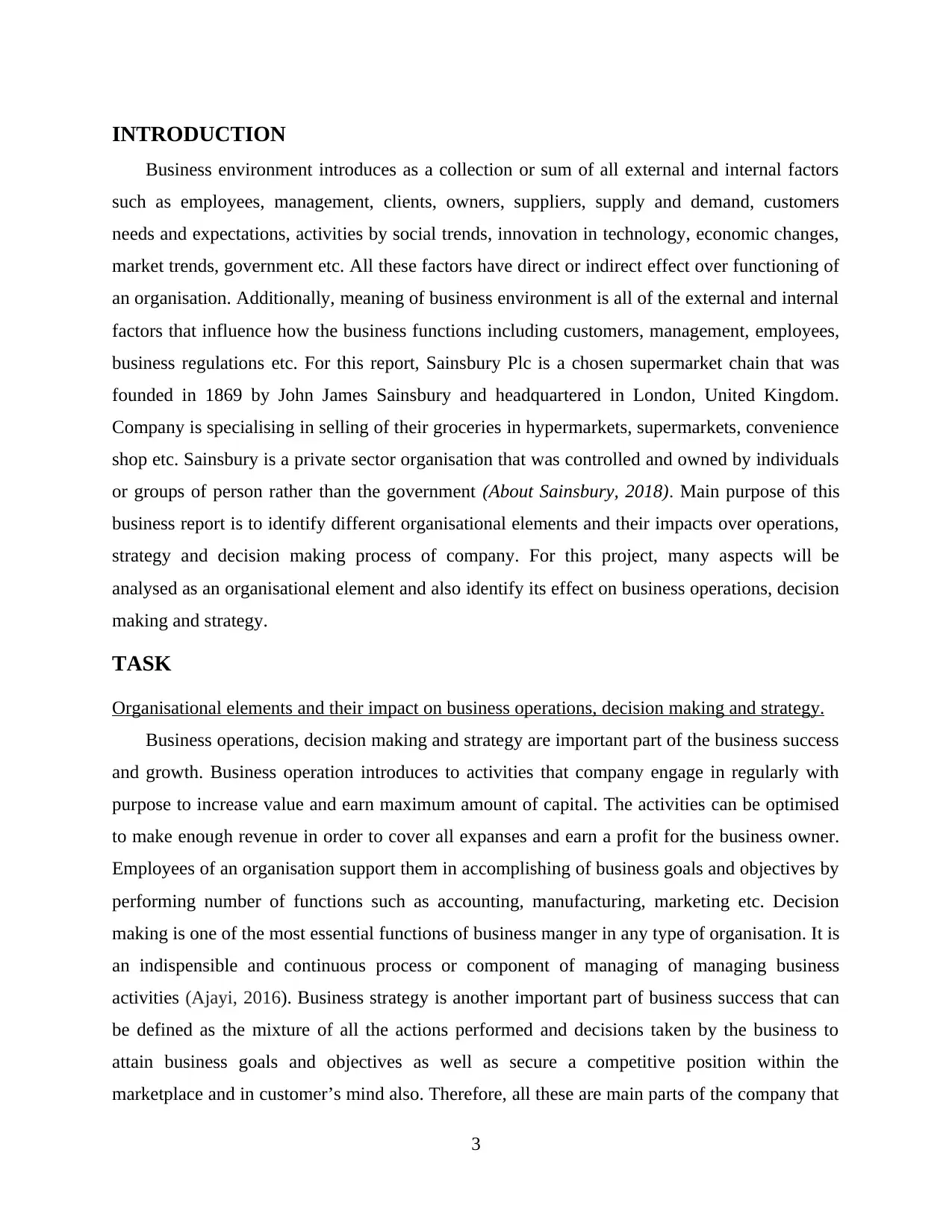
INTRODUCTION
Business environment introduces as a collection or sum of all external and internal factors
such as employees, management, clients, owners, suppliers, supply and demand, customers
needs and expectations, activities by social trends, innovation in technology, economic changes,
market trends, government etc. All these factors have direct or indirect effect over functioning of
an organisation. Additionally, meaning of business environment is all of the external and internal
factors that influence how the business functions including customers, management, employees,
business regulations etc. For this report, Sainsbury Plc is a chosen supermarket chain that was
founded in 1869 by John James Sainsbury and headquartered in London, United Kingdom.
Company is specialising in selling of their groceries in hypermarkets, supermarkets, convenience
shop etc. Sainsbury is a private sector organisation that was controlled and owned by individuals
or groups of person rather than the government (About Sainsbury, 2018). Main purpose of this
business report is to identify different organisational elements and their impacts over operations,
strategy and decision making process of company. For this project, many aspects will be
analysed as an organisational element and also identify its effect on business operations, decision
making and strategy.
TASK
Organisational elements and their impact on business operations, decision making and strategy.
Business operations, decision making and strategy are important part of the business success
and growth. Business operation introduces to activities that company engage in regularly with
purpose to increase value and earn maximum amount of capital. The activities can be optimised
to make enough revenue in order to cover all expanses and earn a profit for the business owner.
Employees of an organisation support them in accomplishing of business goals and objectives by
performing number of functions such as accounting, manufacturing, marketing etc. Decision
making is one of the most essential functions of business manger in any type of organisation. It is
an indispensible and continuous process or component of managing of managing business
activities (Ajayi, 2016). Business strategy is another important part of business success that can
be defined as the mixture of all the actions performed and decisions taken by the business to
attain business goals and objectives as well as secure a competitive position within the
marketplace and in customer’s mind also. Therefore, all these are main parts of the company that
3
Business environment introduces as a collection or sum of all external and internal factors
such as employees, management, clients, owners, suppliers, supply and demand, customers
needs and expectations, activities by social trends, innovation in technology, economic changes,
market trends, government etc. All these factors have direct or indirect effect over functioning of
an organisation. Additionally, meaning of business environment is all of the external and internal
factors that influence how the business functions including customers, management, employees,
business regulations etc. For this report, Sainsbury Plc is a chosen supermarket chain that was
founded in 1869 by John James Sainsbury and headquartered in London, United Kingdom.
Company is specialising in selling of their groceries in hypermarkets, supermarkets, convenience
shop etc. Sainsbury is a private sector organisation that was controlled and owned by individuals
or groups of person rather than the government (About Sainsbury, 2018). Main purpose of this
business report is to identify different organisational elements and their impacts over operations,
strategy and decision making process of company. For this project, many aspects will be
analysed as an organisational element and also identify its effect on business operations, decision
making and strategy.
TASK
Organisational elements and their impact on business operations, decision making and strategy.
Business operations, decision making and strategy are important part of the business success
and growth. Business operation introduces to activities that company engage in regularly with
purpose to increase value and earn maximum amount of capital. The activities can be optimised
to make enough revenue in order to cover all expanses and earn a profit for the business owner.
Employees of an organisation support them in accomplishing of business goals and objectives by
performing number of functions such as accounting, manufacturing, marketing etc. Decision
making is one of the most essential functions of business manger in any type of organisation. It is
an indispensible and continuous process or component of managing of managing business
activities (Ajayi, 2016). Business strategy is another important part of business success that can
be defined as the mixture of all the actions performed and decisions taken by the business to
attain business goals and objectives as well as secure a competitive position within the
marketplace and in customer’s mind also. Therefore, all these are main parts of the company that
3
⊘ This is a preview!⊘
Do you want full access?
Subscribe today to unlock all pages.

Trusted by 1+ million students worldwide
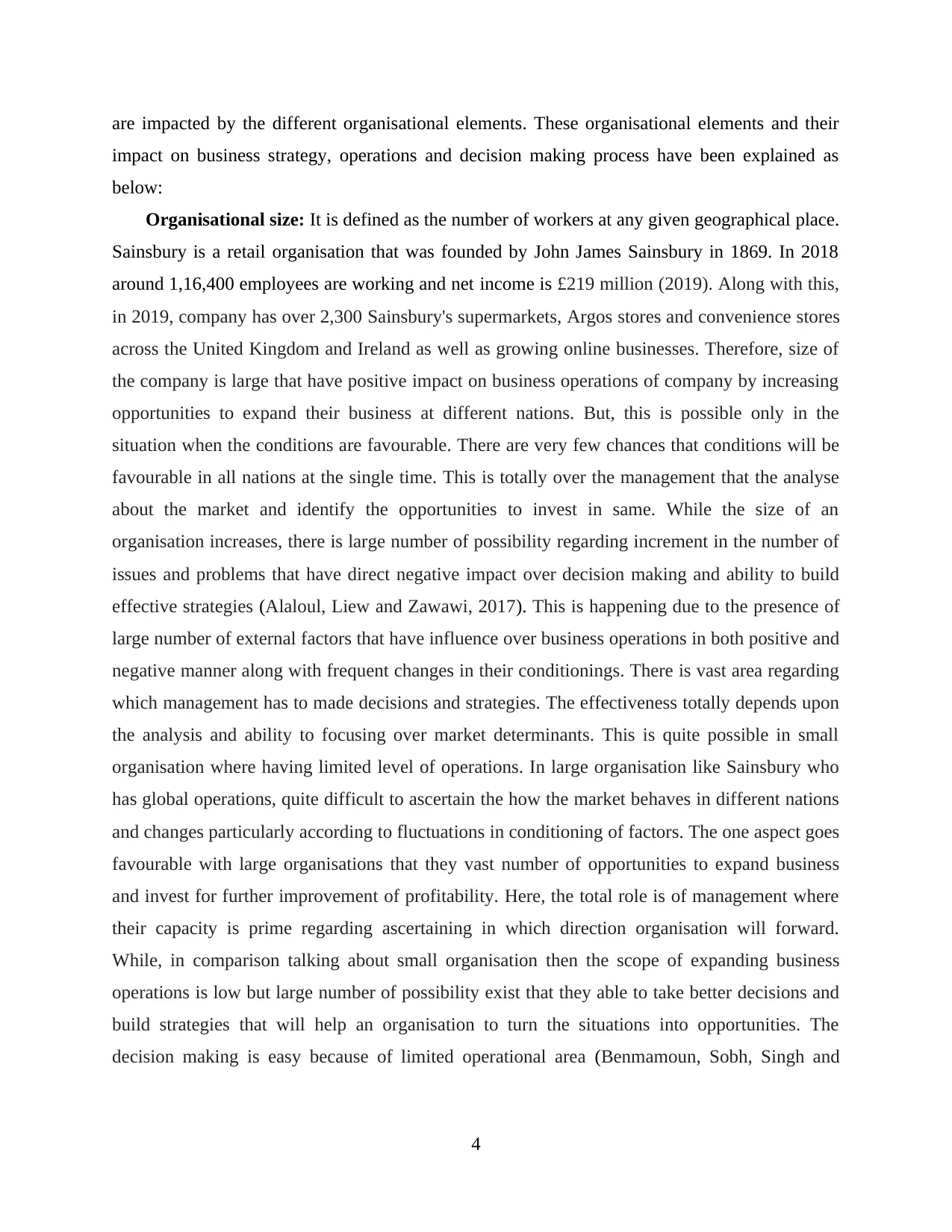
are impacted by the different organisational elements. These organisational elements and their
impact on business strategy, operations and decision making process have been explained as
below:
Organisational size: It is defined as the number of workers at any given geographical place.
Sainsbury is a retail organisation that was founded by John James Sainsbury in 1869. In 2018
around 1,16,400 employees are working and net income is £219 million (2019). Along with this,
in 2019, company has over 2,300 Sainsbury's supermarkets, Argos stores and convenience stores
across the United Kingdom and Ireland as well as growing online businesses. Therefore, size of
the company is large that have positive impact on business operations of company by increasing
opportunities to expand their business at different nations. But, this is possible only in the
situation when the conditions are favourable. There are very few chances that conditions will be
favourable in all nations at the single time. This is totally over the management that the analyse
about the market and identify the opportunities to invest in same. While the size of an
organisation increases, there is large number of possibility regarding increment in the number of
issues and problems that have direct negative impact over decision making and ability to build
effective strategies (Alaloul, Liew and Zawawi, 2017). This is happening due to the presence of
large number of external factors that have influence over business operations in both positive and
negative manner along with frequent changes in their conditionings. There is vast area regarding
which management has to made decisions and strategies. The effectiveness totally depends upon
the analysis and ability to focusing over market determinants. This is quite possible in small
organisation where having limited level of operations. In large organisation like Sainsbury who
has global operations, quite difficult to ascertain the how the market behaves in different nations
and changes particularly according to fluctuations in conditioning of factors. The one aspect goes
favourable with large organisations that they vast number of opportunities to expand business
and invest for further improvement of profitability. Here, the total role is of management where
their capacity is prime regarding ascertaining in which direction organisation will forward.
While, in comparison talking about small organisation then the scope of expanding business
operations is low but large number of possibility exist that they able to take better decisions and
build strategies that will help an organisation to turn the situations into opportunities. The
decision making is easy because of limited operational area (Benmamoun, Sobh, Singh and
4
impact on business strategy, operations and decision making process have been explained as
below:
Organisational size: It is defined as the number of workers at any given geographical place.
Sainsbury is a retail organisation that was founded by John James Sainsbury in 1869. In 2018
around 1,16,400 employees are working and net income is £219 million (2019). Along with this,
in 2019, company has over 2,300 Sainsbury's supermarkets, Argos stores and convenience stores
across the United Kingdom and Ireland as well as growing online businesses. Therefore, size of
the company is large that have positive impact on business operations of company by increasing
opportunities to expand their business at different nations. But, this is possible only in the
situation when the conditions are favourable. There are very few chances that conditions will be
favourable in all nations at the single time. This is totally over the management that the analyse
about the market and identify the opportunities to invest in same. While the size of an
organisation increases, there is large number of possibility regarding increment in the number of
issues and problems that have direct negative impact over decision making and ability to build
effective strategies (Alaloul, Liew and Zawawi, 2017). This is happening due to the presence of
large number of external factors that have influence over business operations in both positive and
negative manner along with frequent changes in their conditionings. There is vast area regarding
which management has to made decisions and strategies. The effectiveness totally depends upon
the analysis and ability to focusing over market determinants. This is quite possible in small
organisation where having limited level of operations. In large organisation like Sainsbury who
has global operations, quite difficult to ascertain the how the market behaves in different nations
and changes particularly according to fluctuations in conditioning of factors. The one aspect goes
favourable with large organisations that they vast number of opportunities to expand business
and invest for further improvement of profitability. Here, the total role is of management where
their capacity is prime regarding ascertaining in which direction organisation will forward.
While, in comparison talking about small organisation then the scope of expanding business
operations is low but large number of possibility exist that they able to take better decisions and
build strategies that will help an organisation to turn the situations into opportunities. The
decision making is easy because of limited operational area (Benmamoun, Sobh, Singh and
4
Paraphrase This Document
Need a fresh take? Get an instant paraphrase of this document with our AI Paraphraser
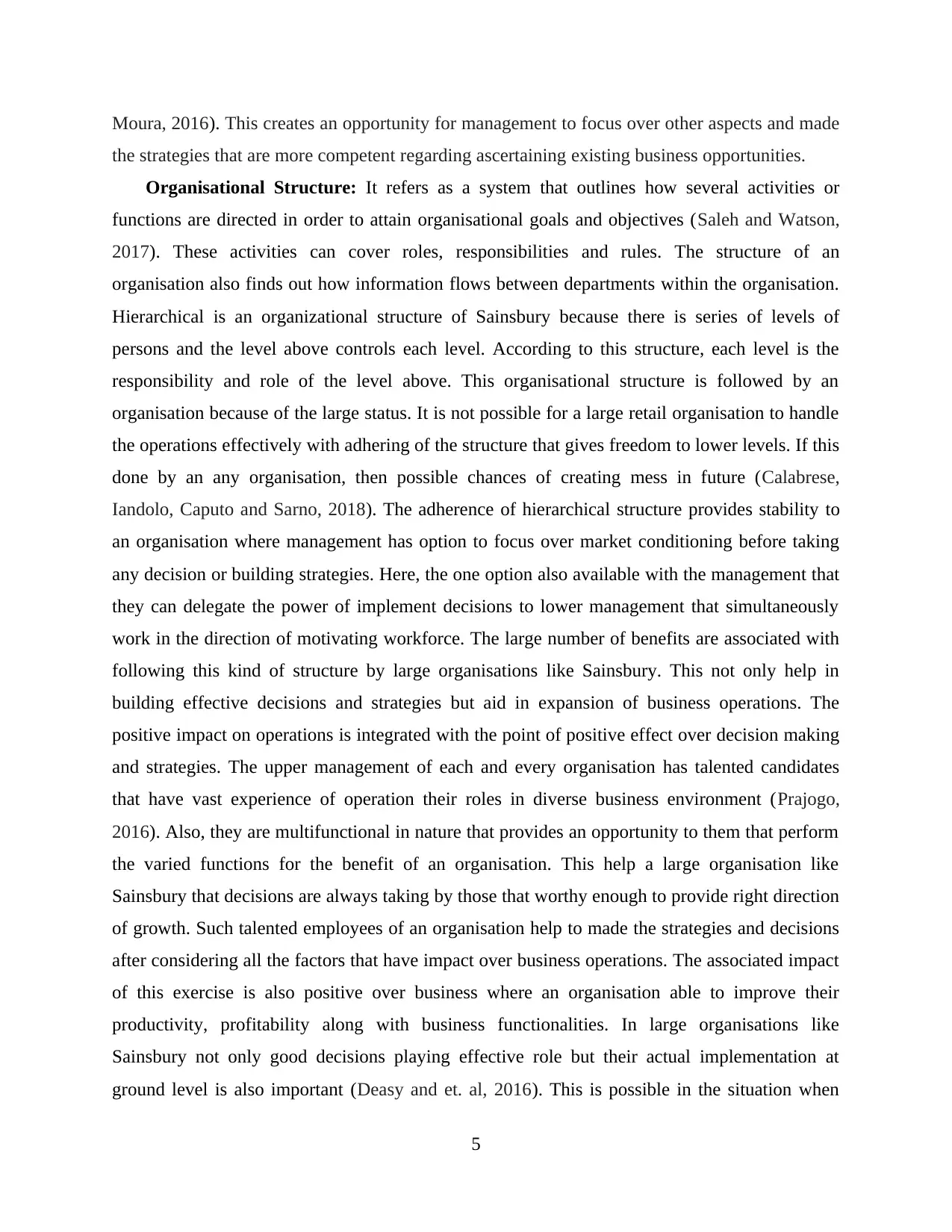
Moura, 2016). This creates an opportunity for management to focus over other aspects and made
the strategies that are more competent regarding ascertaining existing business opportunities.
Organisational Structure: It refers as a system that outlines how several activities or
functions are directed in order to attain organisational goals and objectives (Saleh and Watson,
2017). These activities can cover roles, responsibilities and rules. The structure of an
organisation also finds out how information flows between departments within the organisation.
Hierarchical is an organizational structure of Sainsbury because there is series of levels of
persons and the level above controls each level. According to this structure, each level is the
responsibility and role of the level above. This organisational structure is followed by an
organisation because of the large status. It is not possible for a large retail organisation to handle
the operations effectively with adhering of the structure that gives freedom to lower levels. If this
done by an any organisation, then possible chances of creating mess in future (Calabrese,
Iandolo, Caputo and Sarno, 2018). The adherence of hierarchical structure provides stability to
an organisation where management has option to focus over market conditioning before taking
any decision or building strategies. Here, the one option also available with the management that
they can delegate the power of implement decisions to lower management that simultaneously
work in the direction of motivating workforce. The large number of benefits are associated with
following this kind of structure by large organisations like Sainsbury. This not only help in
building effective decisions and strategies but aid in expansion of business operations. The
positive impact on operations is integrated with the point of positive effect over decision making
and strategies. The upper management of each and every organisation has talented candidates
that have vast experience of operation their roles in diverse business environment (Prajogo,
2016). Also, they are multifunctional in nature that provides an opportunity to them that perform
the varied functions for the benefit of an organisation. This help a large organisation like
Sainsbury that decisions are always taking by those that worthy enough to provide right direction
of growth. Such talented employees of an organisation help to made the strategies and decisions
after considering all the factors that have impact over business operations. The associated impact
of this exercise is also positive over business where an organisation able to improve their
productivity, profitability along with business functionalities. In large organisations like
Sainsbury not only good decisions playing effective role but their actual implementation at
ground level is also important (Deasy and et. al, 2016). This is possible in the situation when
5
the strategies that are more competent regarding ascertaining existing business opportunities.
Organisational Structure: It refers as a system that outlines how several activities or
functions are directed in order to attain organisational goals and objectives (Saleh and Watson,
2017). These activities can cover roles, responsibilities and rules. The structure of an
organisation also finds out how information flows between departments within the organisation.
Hierarchical is an organizational structure of Sainsbury because there is series of levels of
persons and the level above controls each level. According to this structure, each level is the
responsibility and role of the level above. This organisational structure is followed by an
organisation because of the large status. It is not possible for a large retail organisation to handle
the operations effectively with adhering of the structure that gives freedom to lower levels. If this
done by an any organisation, then possible chances of creating mess in future (Calabrese,
Iandolo, Caputo and Sarno, 2018). The adherence of hierarchical structure provides stability to
an organisation where management has option to focus over market conditioning before taking
any decision or building strategies. Here, the one option also available with the management that
they can delegate the power of implement decisions to lower management that simultaneously
work in the direction of motivating workforce. The large number of benefits are associated with
following this kind of structure by large organisations like Sainsbury. This not only help in
building effective decisions and strategies but aid in expansion of business operations. The
positive impact on operations is integrated with the point of positive effect over decision making
and strategies. The upper management of each and every organisation has talented candidates
that have vast experience of operation their roles in diverse business environment (Prajogo,
2016). Also, they are multifunctional in nature that provides an opportunity to them that perform
the varied functions for the benefit of an organisation. This help a large organisation like
Sainsbury that decisions are always taking by those that worthy enough to provide right direction
of growth. Such talented employees of an organisation help to made the strategies and decisions
after considering all the factors that have impact over business operations. The associated impact
of this exercise is also positive over business where an organisation able to improve their
productivity, profitability along with business functionalities. In large organisations like
Sainsbury not only good decisions playing effective role but their actual implementation at
ground level is also important (Deasy and et. al, 2016). This is possible in the situation when
5
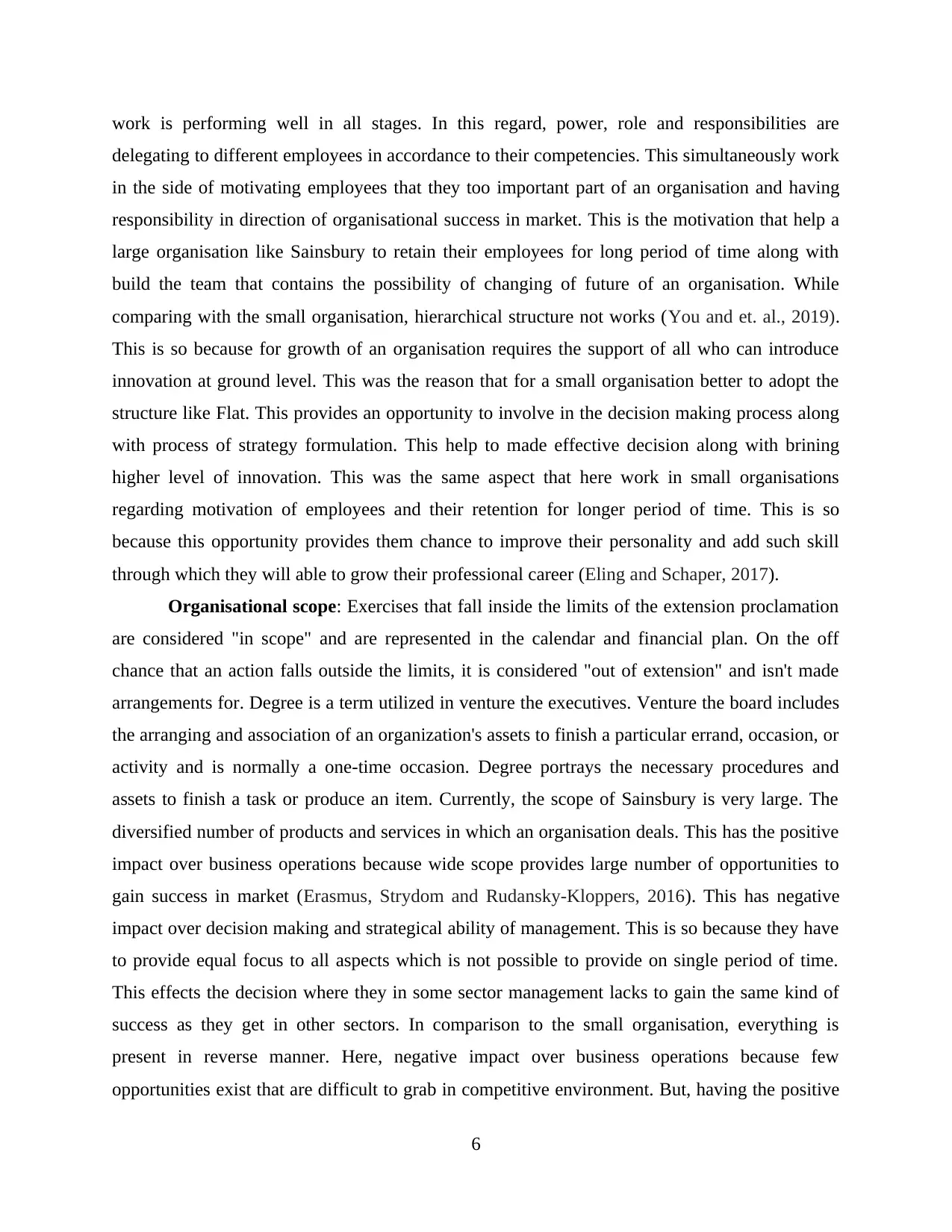
work is performing well in all stages. In this regard, power, role and responsibilities are
delegating to different employees in accordance to their competencies. This simultaneously work
in the side of motivating employees that they too important part of an organisation and having
responsibility in direction of organisational success in market. This is the motivation that help a
large organisation like Sainsbury to retain their employees for long period of time along with
build the team that contains the possibility of changing of future of an organisation. While
comparing with the small organisation, hierarchical structure not works (You and et. al., 2019).
This is so because for growth of an organisation requires the support of all who can introduce
innovation at ground level. This was the reason that for a small organisation better to adopt the
structure like Flat. This provides an opportunity to involve in the decision making process along
with process of strategy formulation. This help to made effective decision along with brining
higher level of innovation. This was the same aspect that here work in small organisations
regarding motivation of employees and their retention for longer period of time. This is so
because this opportunity provides them chance to improve their personality and add such skill
through which they will able to grow their professional career (Eling and Schaper, 2017).
Organisational scope: Exercises that fall inside the limits of the extension proclamation
are considered "in scope" and are represented in the calendar and financial plan. On the off
chance that an action falls outside the limits, it is considered "out of extension" and isn't made
arrangements for. Degree is a term utilized in venture the executives. Venture the board includes
the arranging and association of an organization's assets to finish a particular errand, occasion, or
activity and is normally a one-time occasion. Degree portrays the necessary procedures and
assets to finish a task or produce an item. Currently, the scope of Sainsbury is very large. The
diversified number of products and services in which an organisation deals. This has the positive
impact over business operations because wide scope provides large number of opportunities to
gain success in market (Erasmus, Strydom and Rudansky-Kloppers, 2016). This has negative
impact over decision making and strategical ability of management. This is so because they have
to provide equal focus to all aspects which is not possible to provide on single period of time.
This effects the decision where they in some sector management lacks to gain the same kind of
success as they get in other sectors. In comparison to the small organisation, everything is
present in reverse manner. Here, negative impact over business operations because few
opportunities exist that are difficult to grab in competitive environment. But, having the positive
6
delegating to different employees in accordance to their competencies. This simultaneously work
in the side of motivating employees that they too important part of an organisation and having
responsibility in direction of organisational success in market. This is the motivation that help a
large organisation like Sainsbury to retain their employees for long period of time along with
build the team that contains the possibility of changing of future of an organisation. While
comparing with the small organisation, hierarchical structure not works (You and et. al., 2019).
This is so because for growth of an organisation requires the support of all who can introduce
innovation at ground level. This was the reason that for a small organisation better to adopt the
structure like Flat. This provides an opportunity to involve in the decision making process along
with process of strategy formulation. This help to made effective decision along with brining
higher level of innovation. This was the same aspect that here work in small organisations
regarding motivation of employees and their retention for longer period of time. This is so
because this opportunity provides them chance to improve their personality and add such skill
through which they will able to grow their professional career (Eling and Schaper, 2017).
Organisational scope: Exercises that fall inside the limits of the extension proclamation
are considered "in scope" and are represented in the calendar and financial plan. On the off
chance that an action falls outside the limits, it is considered "out of extension" and isn't made
arrangements for. Degree is a term utilized in venture the executives. Venture the board includes
the arranging and association of an organization's assets to finish a particular errand, occasion, or
activity and is normally a one-time occasion. Degree portrays the necessary procedures and
assets to finish a task or produce an item. Currently, the scope of Sainsbury is very large. The
diversified number of products and services in which an organisation deals. This has the positive
impact over business operations because wide scope provides large number of opportunities to
gain success in market (Erasmus, Strydom and Rudansky-Kloppers, 2016). This has negative
impact over decision making and strategical ability of management. This is so because they have
to provide equal focus to all aspects which is not possible to provide on single period of time.
This effects the decision where they in some sector management lacks to gain the same kind of
success as they get in other sectors. In comparison to the small organisation, everything is
present in reverse manner. Here, negative impact over business operations because few
opportunities exist that are difficult to grab in competitive environment. But, having the positive
6
⊘ This is a preview!⊘
Do you want full access?
Subscribe today to unlock all pages.

Trusted by 1+ million students worldwide
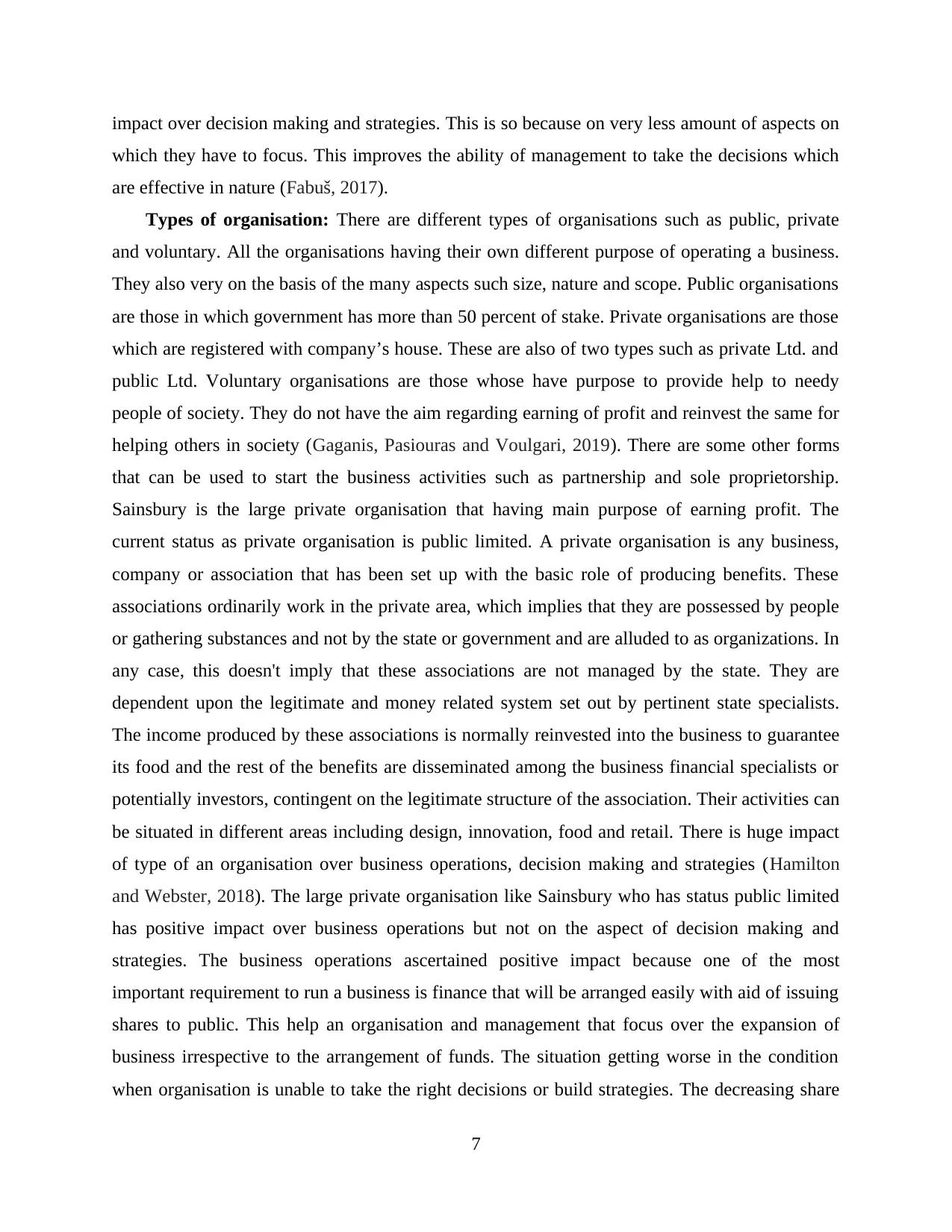
impact over decision making and strategies. This is so because on very less amount of aspects on
which they have to focus. This improves the ability of management to take the decisions which
are effective in nature (Fabuš, 2017).
Types of organisation: There are different types of organisations such as public, private
and voluntary. All the organisations having their own different purpose of operating a business.
They also very on the basis of the many aspects such size, nature and scope. Public organisations
are those in which government has more than 50 percent of stake. Private organisations are those
which are registered with company’s house. These are also of two types such as private Ltd. and
public Ltd. Voluntary organisations are those whose have purpose to provide help to needy
people of society. They do not have the aim regarding earning of profit and reinvest the same for
helping others in society (Gaganis, Pasiouras and Voulgari, 2019). There are some other forms
that can be used to start the business activities such as partnership and sole proprietorship.
Sainsbury is the large private organisation that having main purpose of earning profit. The
current status as private organisation is public limited. A private organisation is any business,
company or association that has been set up with the basic role of producing benefits. These
associations ordinarily work in the private area, which implies that they are possessed by people
or gathering substances and not by the state or government and are alluded to as organizations. In
any case, this doesn't imply that these associations are not managed by the state. They are
dependent upon the legitimate and money related system set out by pertinent state specialists.
The income produced by these associations is normally reinvested into the business to guarantee
its food and the rest of the benefits are disseminated among the business financial specialists or
potentially investors, contingent on the legitimate structure of the association. Their activities can
be situated in different areas including design, innovation, food and retail. There is huge impact
of type of an organisation over business operations, decision making and strategies (Hamilton
and Webster, 2018). The large private organisation like Sainsbury who has status public limited
has positive impact over business operations but not on the aspect of decision making and
strategies. The business operations ascertained positive impact because one of the most
important requirement to run a business is finance that will be arranged easily with aid of issuing
shares to public. This help an organisation and management that focus over the expansion of
business irrespective to the arrangement of funds. The situation getting worse in the condition
when organisation is unable to take the right decisions or build strategies. The decreasing share
7
which they have to focus. This improves the ability of management to take the decisions which
are effective in nature (Fabuš, 2017).
Types of organisation: There are different types of organisations such as public, private
and voluntary. All the organisations having their own different purpose of operating a business.
They also very on the basis of the many aspects such size, nature and scope. Public organisations
are those in which government has more than 50 percent of stake. Private organisations are those
which are registered with company’s house. These are also of two types such as private Ltd. and
public Ltd. Voluntary organisations are those whose have purpose to provide help to needy
people of society. They do not have the aim regarding earning of profit and reinvest the same for
helping others in society (Gaganis, Pasiouras and Voulgari, 2019). There are some other forms
that can be used to start the business activities such as partnership and sole proprietorship.
Sainsbury is the large private organisation that having main purpose of earning profit. The
current status as private organisation is public limited. A private organisation is any business,
company or association that has been set up with the basic role of producing benefits. These
associations ordinarily work in the private area, which implies that they are possessed by people
or gathering substances and not by the state or government and are alluded to as organizations. In
any case, this doesn't imply that these associations are not managed by the state. They are
dependent upon the legitimate and money related system set out by pertinent state specialists.
The income produced by these associations is normally reinvested into the business to guarantee
its food and the rest of the benefits are disseminated among the business financial specialists or
potentially investors, contingent on the legitimate structure of the association. Their activities can
be situated in different areas including design, innovation, food and retail. There is huge impact
of type of an organisation over business operations, decision making and strategies (Hamilton
and Webster, 2018). The large private organisation like Sainsbury who has status public limited
has positive impact over business operations but not on the aspect of decision making and
strategies. The business operations ascertained positive impact because one of the most
important requirement to run a business is finance that will be arranged easily with aid of issuing
shares to public. This help an organisation and management that focus over the expansion of
business irrespective to the arrangement of funds. The situation getting worse in the condition
when organisation is unable to take the right decisions or build strategies. The decreasing share
7
Paraphrase This Document
Need a fresh take? Get an instant paraphrase of this document with our AI Paraphraser
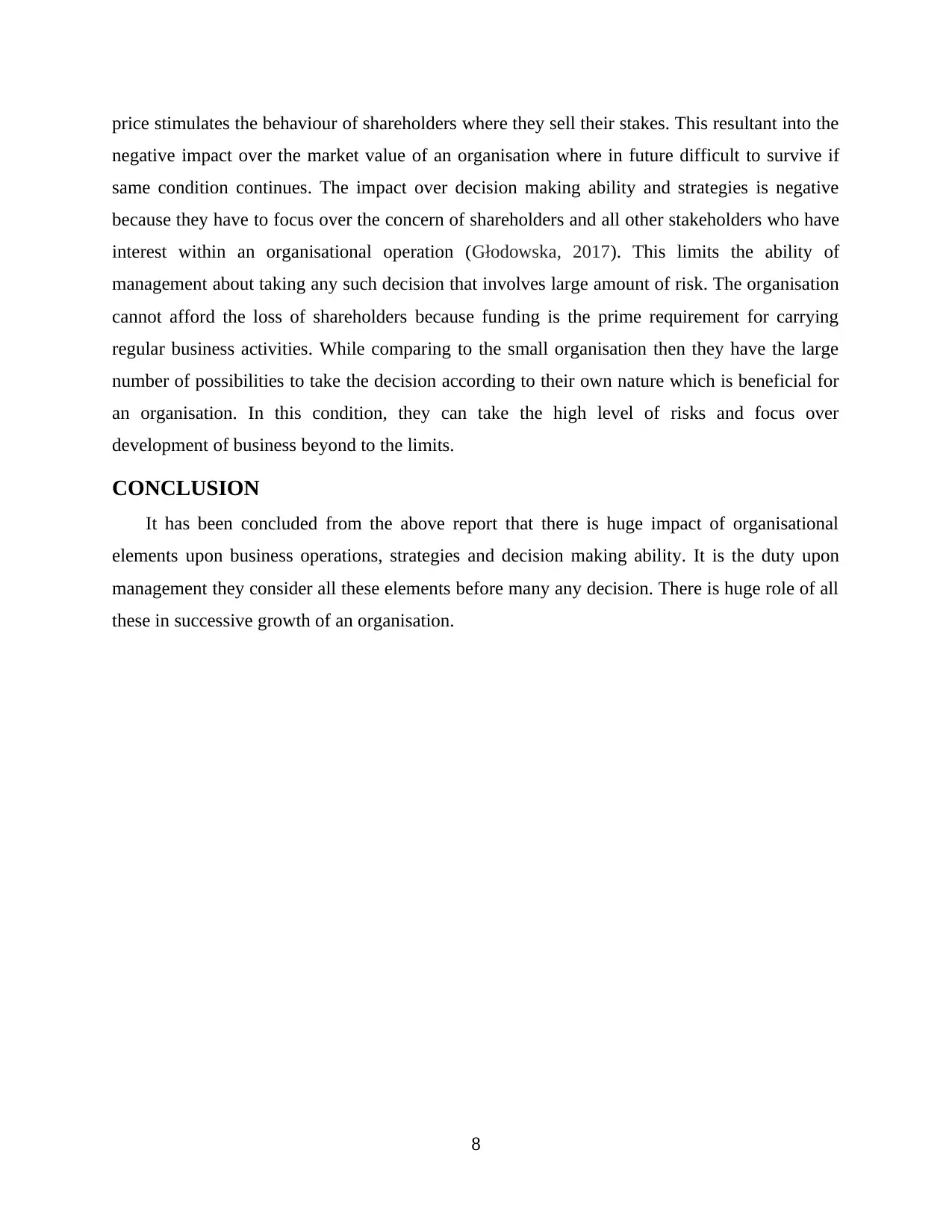
price stimulates the behaviour of shareholders where they sell their stakes. This resultant into the
negative impact over the market value of an organisation where in future difficult to survive if
same condition continues. The impact over decision making ability and strategies is negative
because they have to focus over the concern of shareholders and all other stakeholders who have
interest within an organisational operation (Głodowska, 2017). This limits the ability of
management about taking any such decision that involves large amount of risk. The organisation
cannot afford the loss of shareholders because funding is the prime requirement for carrying
regular business activities. While comparing to the small organisation then they have the large
number of possibilities to take the decision according to their own nature which is beneficial for
an organisation. In this condition, they can take the high level of risks and focus over
development of business beyond to the limits.
CONCLUSION
It has been concluded from the above report that there is huge impact of organisational
elements upon business operations, strategies and decision making ability. It is the duty upon
management they consider all these elements before many any decision. There is huge role of all
these in successive growth of an organisation.
8
negative impact over the market value of an organisation where in future difficult to survive if
same condition continues. The impact over decision making ability and strategies is negative
because they have to focus over the concern of shareholders and all other stakeholders who have
interest within an organisational operation (Głodowska, 2017). This limits the ability of
management about taking any such decision that involves large amount of risk. The organisation
cannot afford the loss of shareholders because funding is the prime requirement for carrying
regular business activities. While comparing to the small organisation then they have the large
number of possibilities to take the decision according to their own nature which is beneficial for
an organisation. In this condition, they can take the high level of risks and focus over
development of business beyond to the limits.
CONCLUSION
It has been concluded from the above report that there is huge impact of organisational
elements upon business operations, strategies and decision making ability. It is the duty upon
management they consider all these elements before many any decision. There is huge role of all
these in successive growth of an organisation.
8
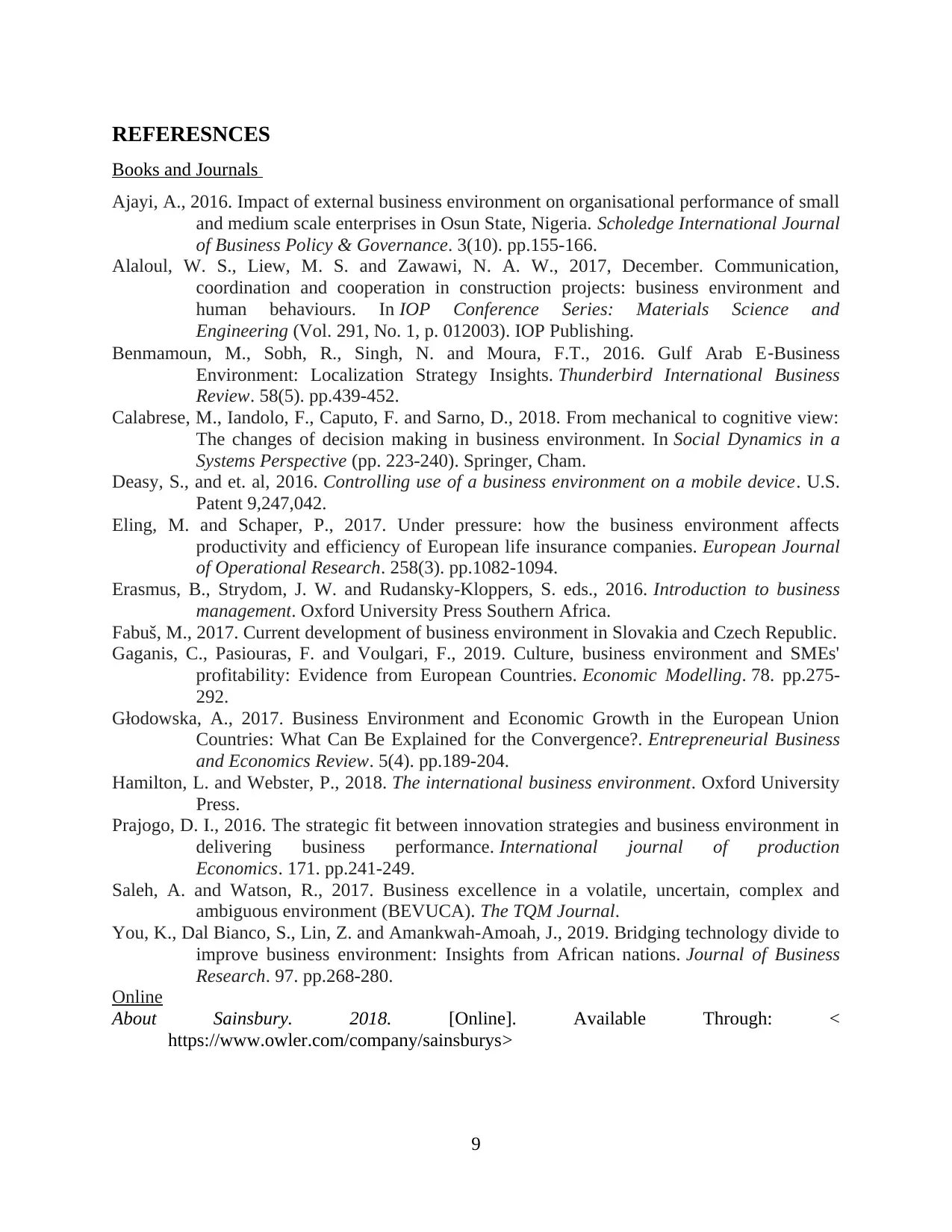
REFERESNCES
Books and Journals
Ajayi, A., 2016. Impact of external business environment on organisational performance of small
and medium scale enterprises in Osun State, Nigeria. Scholedge International Journal
of Business Policy & Governance. 3(10). pp.155-166.
Alaloul, W. S., Liew, M. S. and Zawawi, N. A. W., 2017, December. Communication,
coordination and cooperation in construction projects: business environment and
human behaviours. In IOP Conference Series: Materials Science and
Engineering (Vol. 291, No. 1, p. 012003). IOP Publishing.
Benmamoun, M., Sobh, R., Singh, N. and Moura, F.T., 2016. Gulf Arab E‐Business
Environment: Localization Strategy Insights. Thunderbird International Business
Review. 58(5). pp.439-452.
Calabrese, M., Iandolo, F., Caputo, F. and Sarno, D., 2018. From mechanical to cognitive view:
The changes of decision making in business environment. In Social Dynamics in a
Systems Perspective (pp. 223-240). Springer, Cham.
Deasy, S., and et. al, 2016. Controlling use of a business environment on a mobile device. U.S.
Patent 9,247,042.
Eling, M. and Schaper, P., 2017. Under pressure: how the business environment affects
productivity and efficiency of European life insurance companies. European Journal
of Operational Research. 258(3). pp.1082-1094.
Erasmus, B., Strydom, J. W. and Rudansky-Kloppers, S. eds., 2016. Introduction to business
management. Oxford University Press Southern Africa.
Fabuš, M., 2017. Current development of business environment in Slovakia and Czech Republic.
Gaganis, C., Pasiouras, F. and Voulgari, F., 2019. Culture, business environment and SMEs'
profitability: Evidence from European Countries. Economic Modelling. 78. pp.275-
292.
Głodowska, A., 2017. Business Environment and Economic Growth in the European Union
Countries: What Can Be Explained for the Convergence?. Entrepreneurial Business
and Economics Review. 5(4). pp.189-204.
Hamilton, L. and Webster, P., 2018. The international business environment. Oxford University
Press.
Prajogo, D. I., 2016. The strategic fit between innovation strategies and business environment in
delivering business performance. International journal of production
Economics. 171. pp.241-249.
Saleh, A. and Watson, R., 2017. Business excellence in a volatile, uncertain, complex and
ambiguous environment (BEVUCA). The TQM Journal.
You, K., Dal Bianco, S., Lin, Z. and Amankwah-Amoah, J., 2019. Bridging technology divide to
improve business environment: Insights from African nations. Journal of Business
Research. 97. pp.268-280.
Online
About Sainsbury. 2018. [Online]. Available Through: <
https://www.owler.com/company/sainsburys>
9
Books and Journals
Ajayi, A., 2016. Impact of external business environment on organisational performance of small
and medium scale enterprises in Osun State, Nigeria. Scholedge International Journal
of Business Policy & Governance. 3(10). pp.155-166.
Alaloul, W. S., Liew, M. S. and Zawawi, N. A. W., 2017, December. Communication,
coordination and cooperation in construction projects: business environment and
human behaviours. In IOP Conference Series: Materials Science and
Engineering (Vol. 291, No. 1, p. 012003). IOP Publishing.
Benmamoun, M., Sobh, R., Singh, N. and Moura, F.T., 2016. Gulf Arab E‐Business
Environment: Localization Strategy Insights. Thunderbird International Business
Review. 58(5). pp.439-452.
Calabrese, M., Iandolo, F., Caputo, F. and Sarno, D., 2018. From mechanical to cognitive view:
The changes of decision making in business environment. In Social Dynamics in a
Systems Perspective (pp. 223-240). Springer, Cham.
Deasy, S., and et. al, 2016. Controlling use of a business environment on a mobile device. U.S.
Patent 9,247,042.
Eling, M. and Schaper, P., 2017. Under pressure: how the business environment affects
productivity and efficiency of European life insurance companies. European Journal
of Operational Research. 258(3). pp.1082-1094.
Erasmus, B., Strydom, J. W. and Rudansky-Kloppers, S. eds., 2016. Introduction to business
management. Oxford University Press Southern Africa.
Fabuš, M., 2017. Current development of business environment in Slovakia and Czech Republic.
Gaganis, C., Pasiouras, F. and Voulgari, F., 2019. Culture, business environment and SMEs'
profitability: Evidence from European Countries. Economic Modelling. 78. pp.275-
292.
Głodowska, A., 2017. Business Environment and Economic Growth in the European Union
Countries: What Can Be Explained for the Convergence?. Entrepreneurial Business
and Economics Review. 5(4). pp.189-204.
Hamilton, L. and Webster, P., 2018. The international business environment. Oxford University
Press.
Prajogo, D. I., 2016. The strategic fit between innovation strategies and business environment in
delivering business performance. International journal of production
Economics. 171. pp.241-249.
Saleh, A. and Watson, R., 2017. Business excellence in a volatile, uncertain, complex and
ambiguous environment (BEVUCA). The TQM Journal.
You, K., Dal Bianco, S., Lin, Z. and Amankwah-Amoah, J., 2019. Bridging technology divide to
improve business environment: Insights from African nations. Journal of Business
Research. 97. pp.268-280.
Online
About Sainsbury. 2018. [Online]. Available Through: <
https://www.owler.com/company/sainsburys>
9
⊘ This is a preview!⊘
Do you want full access?
Subscribe today to unlock all pages.

Trusted by 1+ million students worldwide
1 out of 9
Related Documents
Your All-in-One AI-Powered Toolkit for Academic Success.
+13062052269
info@desklib.com
Available 24*7 on WhatsApp / Email
![[object Object]](/_next/static/media/star-bottom.7253800d.svg)
Unlock your academic potential
Copyright © 2020–2025 A2Z Services. All Rights Reserved. Developed and managed by ZUCOL.





